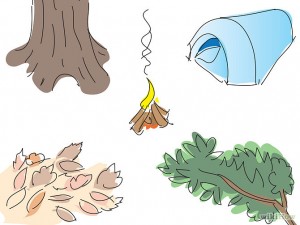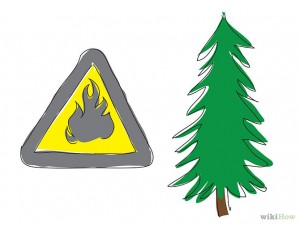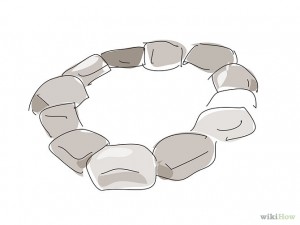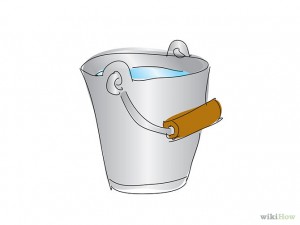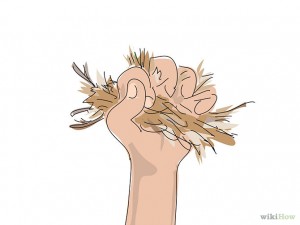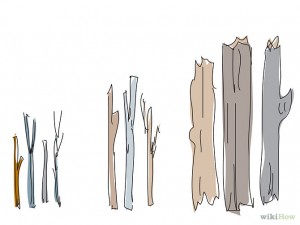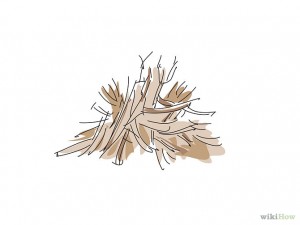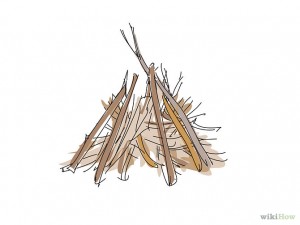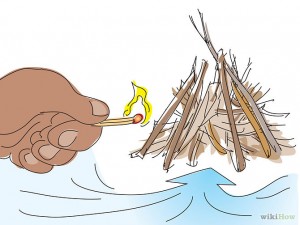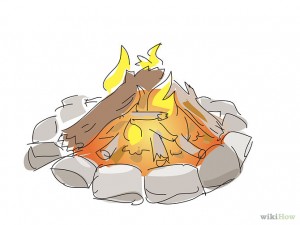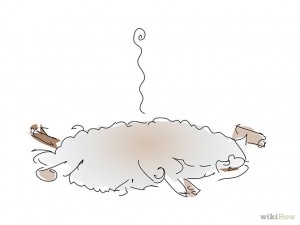When you are out in the wilderness, it is a custom and tradition to build a campfire. The choice is up to you what kind you want, or if you want to use it to cook food.
Situate the fire at least 10 feet (3.0 m) away from tents, trees, roots, overhanging boughs or dry leaves, and other flammable items if there’s no fire ring available.
Make sure you have a flat area, preferably dug a few inches into the ground to contain the fire, but if you’re desperate, just make sure there are no sticks, leaves, or roots in the way. Also note that roots under the ground can catch on fire and spread out causing a fire hazard several feet from your location.
Clear a space 29 to 32 inches (73.7 to 81.3 cm) across.
If there is less than 2 feet (0.6 m) of soft snow, this can be cleared away with snow shoes or by kicking.
If it is hot and you are surrounded by a lot of pine trees, take special care to set the fire in a vast clearing, as green pine trees are extremely flammable themselves as is the gaseous oil they expire.
Make a ring of rocks if one isn’t already there. This will help to contain the fire, thus preventing forest fires. However, don’t build your fire against a boulder or other rocks, as it may leave unsightly burn marks.
Avoid rocks that might be saturated with water, as steam pressure build up within the rocks can lead to explosive fracturing that may injure nearby people, so try to choose rocks from high and dry areas.
Plan a fire control plan. Prepare a bucket of water for each tent and an especially large bucket for the campfire location. Agree on the maximum volume of the fire.
Gather firewood and kindling using only fallen branches. Gather twigs and sticks and divide them into three categories: (a) twigs less than a quarter inch in diameter (four of them together should be no thicker than your pinky), (b) sticks no more than an inch thick (about the thickness of your thumb), and (c) larger sticks up to three inches in diameter (about wrist-sized) and set these aside. This doesn’t have to be perfect and after building a few fires, you’ll get a feel for how these categories pertain to stages of the fire.
The fuel should be as dry as possible. Look under logs and roots to find dry wood. Also look up in trees for fallen branches and deadwood that have hung up in a live tree. Clumps of pitch and birch bark make good fire starters. Birch can be set aflame even wet, and burns long because of its high sap content.
If you have a saw and ax, dry kindling can be split out of the centre of standing dead wood. This will be dry even in the wettest conditions.
Note that many parks and wilderness areas even forbid gathering fallen material, which plays an important role in the ecosystem.
Gather up a dense handful of pine straw, leaves, or any other similar plant remains (grab as much as possible with one hand – have some fuel busting out of the gaps in your hand). The key here is to balance exposed surface area and density – pine straw works well because the pieces have such small diameters and bunch together very nicely, but sunbaked moss, shaved bark, lichen, and even some oily green plant matter can perform nicely. If you’re forced to use larger pieces of starter fuel such as paper or large leaves, try ripping them into thin strips (as thin as possible) before lighting.
Make sure this fuel is as dry as possible. If you are having trouble gathering dry material, make sure you dry some suitable fuel at the fire and save it for later. If you are trying to start a fire in damp conditions, any material on or near the ground will be wet as will the lower dead branches of trees. Look for dry material in sheltered locations (under rocks, logs, in holes, etc.). Birch bark, pitch, or even some green plants like pine or sassafras will burn even if it is wet.
Build a small, loose pile of kindling, making sure to allow space for air to feed the fire. Include paper scraps, dry plant matter, and any type of wood shavings or straw and other small, flammable items.
Either construct a pyramid or a lean-to, also known as a tepee:
For a pyramid, make an inward pointing tepee of dry twigs and small sticks around and above the kindling pile, leaving a gap on the side for entering air.
For a lean-to, lay down one piece of wood of about two inches in diameter. Use this to lean your smallest kindling against so that you have an air space underneath. If you have birch bark or pitch, place this under your kindling.
Light the kindling with a match.
Add increasingly larger sticks and then logs as the fire grows in strength, always leaving enough space between them for the fire to breathe. As you start placing larger twigs on the fire, use a little more rhyme and reason. For instance, you might wish to criss-cross the handfuls of twigs as you lay them down so that the fire can get air. Place your largest sticks in an arrangement that gives them stability and exposure to the fire without suppressing the airflow to the heart of the fire.
When your fire is done, take special care to completely, excessively extinguish every last ember.
http://www.wikihow.com/Build-a-Campfire

